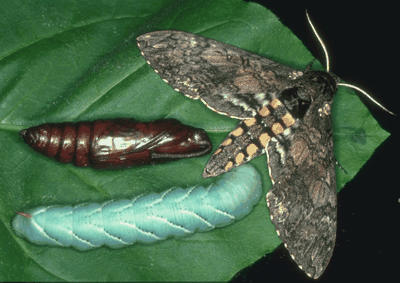 Brown pupa, caterpillar, and adult moth of the tobacco hornworm.
Brown pupa, caterpillar, and adult moth of the tobacco hornworm.Photograph from Dr. Richard Vogt's page: http://zebra.biol.sc.edu/moth/manduca-l.html
Faithful readers may remember my dear friend Martha Weiss, who studies caterpillar learning at Georgetown University. Well, while I was in Nebraska on March 10, an interview with Martha aired on National Public Radio's Morning Edition. Elegant experiments in Martha's lab at Georgetown U. have shown that caterpillars of the tobacco hornworm, when exposed to a chemical odor at the same time they are given a mild electric shock, learn to avoid the odor. That's not that surprising; a measure of intelligence is needed for self-preservation whether you're a worm or a wapiti. I don't know if you've been surprised by a huge sea-green tobacco hornworm while picking tomatoes, had it rear up and click menacingly at you. Yikes. I have. Those things give me the ooks. So many of them wind up being parasitized by wasps, and dying badly with white cocoons sprouting all over their bodies, that I never remove them from my tomato plants any more. They can have the darn tomato vines. We need more hornworms around here.
OK. Back to Martha's work, educating hornworms. Here's the cool part: After metamorphosis, the adult tobacco hornworm moths that were exposed to aversive conditioning as fifth-instar caterpillars remembered the odor associated with shocks, and also avoided it. Metamorphosis, in which a caterpillar spins itself into a silken cocoon, makes a hard pupal shell within that cocoon, and essentially turns to goo inside the pupal shell before reorganizing as a moth, is a complete meltdown of the caterpillar's organs. How in the world would a memory survive the meltdown and reorganization of the caterpillar's brain? But it does, it does, and Martha and her colleagues are asking more questions about the process and doubtless designing more experiments. If you'd like to hear Martha talking about it, with her delightfully puckish sense of humor, listen here.
 Martha with a luna moth pancake. With that one creation, she forever changed the face and execution of pancake breakfasts on Indigo Hill.
Martha with a luna moth pancake. With that one creation, she forever changed the face and execution of pancake breakfasts on Indigo Hill.So I was thinking about Martha and her studies of caterpillar intelligence as I walked down the trails at Los Tarrales. I spied a brown leaf that didn't look quite natural, resting as it did on a green leaf, and suspected that there might be a caterpillar beneath.
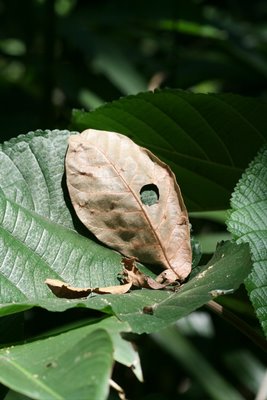 There was something about the way it was resting on the green leaf, and the little porthole, that made me want to lift it up. Sure enough, the leaf was pasted down with silk, and underneath was a green caterpillar, a pretty mad one, in fact. I figure he uses the porthole to enter and exit his safe little vault. Obviously he's not much for housekeeping; he was pooping inside the house. Tsk. I replaced the structure as best I could, hoping he could stick it back down before a bird caught on to the ruse.
There was something about the way it was resting on the green leaf, and the little porthole, that made me want to lift it up. Sure enough, the leaf was pasted down with silk, and underneath was a green caterpillar, a pretty mad one, in fact. I figure he uses the porthole to enter and exit his safe little vault. Obviously he's not much for housekeeping; he was pooping inside the house. Tsk. I replaced the structure as best I could, hoping he could stick it back down before a bird caught on to the ruse.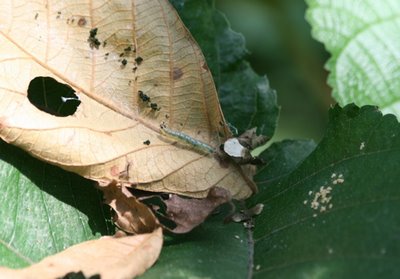
I encountered a gorgeous butterfly, black with broad electric-blue bars on fore and hind wing. I wasn't able to find a Latin name for it, but suspect it is related to the morphos. In true morpho fashion, it was imbibing phosphates and Lord knows what else from a very stinky dog dropping.
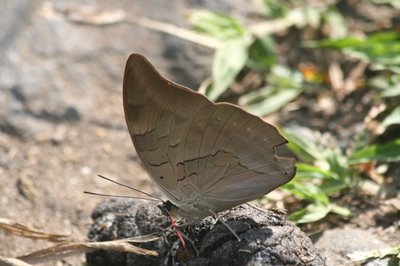
It was so absorbed in its imbibing that it allowed me to pick it up by gently pinching its forewing edge. I got a peek at the electric blue stripes on the dorsal surfaces before releasing it. Butterflies do this because they need the chemicals they get from rotting fruit, mud, droppings, urine, and even detergent (they'll imbibe from soapy clothes) to make the pheromones they need to communicate with the opposite sex.
Here's another common butterfly at Los Tarrales: the cracker, so named for the snapping sound it makes when it takes off. It's got the lichen look down.
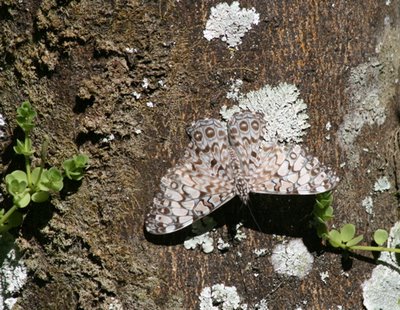
There is so much to see at Los Tarrales that it's like a wonderland for a naturalist. Added to the native fauna is the always-surprising array of ornamentals planted here and there. This is one branch of a variegated Indian rubber tree that must have been 50 feet tall.
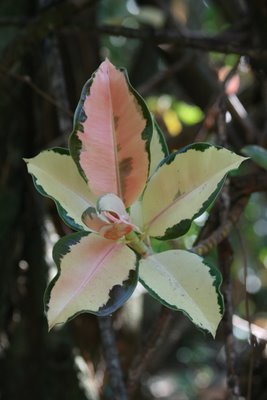
The pink leaves glowed like an exotic flower in the dark understory.
Everywhere you look, there are flowers, like these gingers.
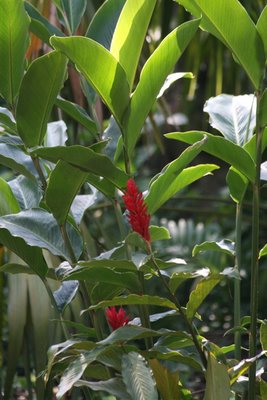 Yes, the ginger root we put in stir-fry is related to this lovely plant. Makes you want to take one out of the fridge door and plant it, doesn't it?
Yes, the ginger root we put in stir-fry is related to this lovely plant. Makes you want to take one out of the fridge door and plant it, doesn't it? Here are the Torch Ginger Girls, Liz, Zick and Lisa, holding three of the amazing flowers that are grown here for sale within Guatemala. Bouquets are everywhere at Los Tarrales, full of the most surprising forms and colors, and it's unutterably cool to wander among the flower plantations and see them on the hoof. We're backed up against the native bamboo that gives Los Tarrales its name.
Here are the Torch Ginger Girls, Liz, Zick and Lisa, holding three of the amazing flowers that are grown here for sale within Guatemala. Bouquets are everywhere at Los Tarrales, full of the most surprising forms and colors, and it's unutterably cool to wander among the flower plantations and see them on the hoof. We're backed up against the native bamboo that gives Los Tarrales its name.Just a birdie before I go: an orange-fronted parakeet, one of many in screaming flocks that bullet overhead constantly. It's hard hard hard to get a decent picture of a psittacine, as they're wary and flighty. But this one is diagnostic, even if its front (the area over the bill) is more rusty than orange.
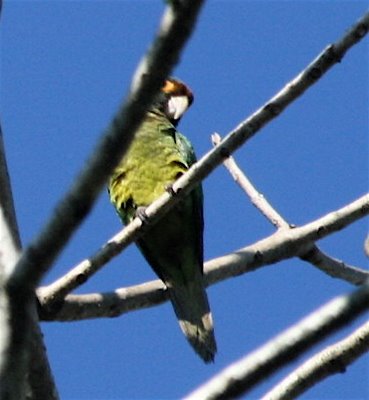
Speaking of parrots, my NPR commentary stayed at #1 Most Emailed from Friday evening through midday Tuesday--a record!-- when somebody named Obama made a speech about racism that some people apparently thought was more compelling and important than the antics of an aging parrot somewhere in backwoods Ohio. No accounting for taste, I guess.
Oh, it feels good to go back to the heat and succor of Guatemala, as the rain pours from leaden skies in soggy gray old Ohio. The spring peepers sang for the first time last night. They're probably the only people happy about this deluge around here. Hoping Mary's home state is getting well soaked!






14 comments:
Thank you, Julie. The rain began at 5pm - a nice, sweet soaking rain that might last until midnight. Makes me very sleepy...
The way you describe moths and caterpillars sounds creepy but every word intrigues me, I met a luna moth last summer and watched it rumble and shake like a funny car and I stood back.
Guate is very cool. Cool birds, flowers, and people.
Alrighty--poop partaking butterflies. What won't I learn next when visiting the Science Chimp.
I must say--at first glance the exotic flowers being held by the Torch Ginger girls looked for all the world like. . .red feather dusters.
Hey Jules,Wish we still had those humongous flowers! I could use one about now in the dreary northland.
As far as your butterfly...there was one on the road just after the Yellow-bellied Flycatcher spot...but it was too fast to point out. So my guess is
One-spotted Prepona--Archaeoprepona demophon.
Jeff videotaped the first record in Texas back in November after the RGV Birding Festival. Terry Fuller found it. Jeff caught it all on tape. It is pretty cute to hear the excitement.
http://www.youtube.com/watch?v=xjFPqu44Z_0
Is it your butterfly?
Well, mine has that outrageous pink proboscis, and the underwing markings almost all add up. I remember a bar of vivid blue midway across the hindwing, and a whitish spot on the forewing upper surface...I'll take it! Thanks, Wizzy! How cool is that, that you could give us a link to the video??
Glad to help out a friend. I am just glad you got to see the bug! Fantastic creature!
You've reduced me to a ten year old again - WOW LOOK, EWWW COOL, OH MAN! It just doesn't get any better - birds, butterflies, caterpillars, cocoons, pupae and then combined with all those luscious words of biologic reference embedded in the most perfectly crafted sentences....suffice to say, after this I am now going out in the yard to find some dog doo with which to balance my raging pheromones. Your writing is like a dose of viagra for the nature deficient. Guatemala here I come!!!
Your Guatemala posts sound more and more like a kid turned loose in a candy store! :-)
Super interesting stuff!!
Beautiful cracker picture!
Your posts from Los Tarrales are amazing!
Wonderful moth photos, julie. It's just so nice to see all these winged creatures while we are still deep in the cold gray of winter here. I did see a tiny moth yesterday. My heart soared as high as it did.
Hope the weather has gotten better for you.
OK. I'm fascinated with that aversion behavior surviving metamorphosis. It's eerily, creepily wonderful.
And yes. It always irritated me that I couldn't be cooler about hornworm ambushes.
Have you read the poem
Hornworm: Autumn Lamentation
by Stanley Kunitz ?
Google it. Read it. Then hug somebody quick and throw open the windows and listen to peepers.
Such a gift you give me, Cathy. I must share it:
Stanley Kunitz - Hornworm: Autumn Lamentation
Since that first morning when I crawled
into the world, a naked grubby thing,
and found the world unkind,
my dearest faith has been that this
is but a trial: I shall be changed.
In my imaginings I have already spent
my brooding winter underground,
unfolded silky powdered wings, and climbed
into the air, free as a puff of cloud
to sail over the steaming fields,
alighting anywhere I pleased,
thrusting into deep tubular flowers.
It is not so: there may be nectar
in those cups, but not for me.
All day, all night, I carry on my back
embedded in my flesh, two rows
of little white cocoons,
so neatly stacked
they look like eggs in a crate.
And I am eaten half away.
If I can gather strength enough
I'll try to burrow under a stone
and spin myself a purse
in which to sleep away the cold;
though when the sun kisses the earth
again, I know I won't be there.
Instead, out of my chrysalis
will break, like robbers from a tomb,
a swarm of parasitic flies,
leaving my wasted husk behind.
Sir, you with the red snippers
in your hand, hovering over me,
casting your shadow, I greet you,
whether you come as an angel of death
or of mercy. But tell me,
before you choose to slice me in two:
Who can understand the ways
of the Great Worm in the Sky?
Julie,
I was in Guatemala about the same time at the Mission in San Lucas. Good to see your photos. Beautiful place and cannot wait to return. I saw a bird pollinating a banana tree and it looked like a big hummingbird and was orange?
@Dragon Rescuer, I would think so. My guess is that the moth emerges from the pupal case underground, digs up through the soil with strong front legs, and then hangs itself up for the process of pumping out its wings, anyway. There's no way it could pump them out if it weren't hanging, so...If you have it in an artificial situation I would put the thing it's hanging from low, and very close to a soft substrate, lest it fall and injure the developing wings.
Post a Comment